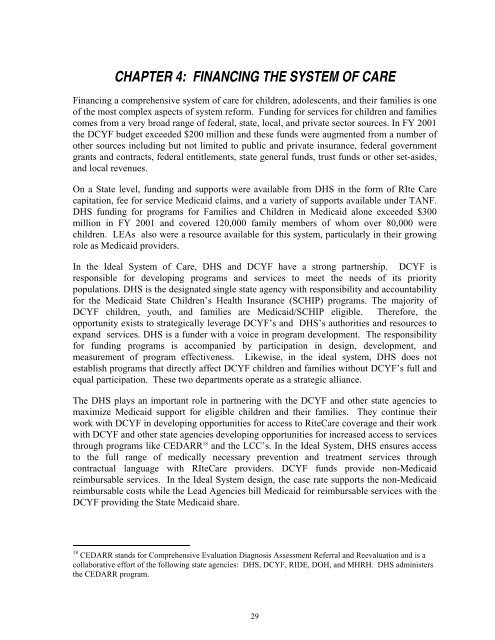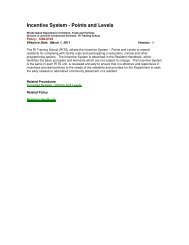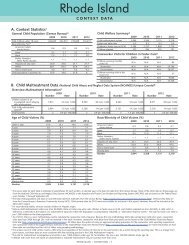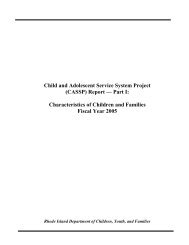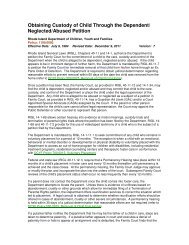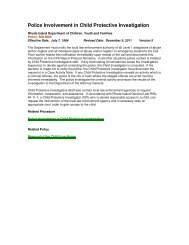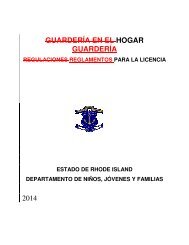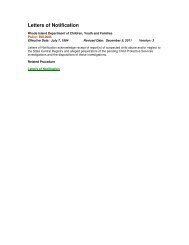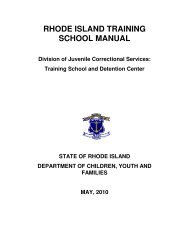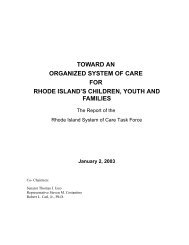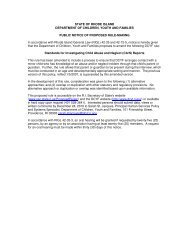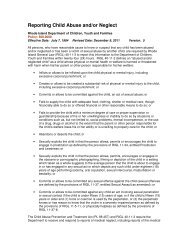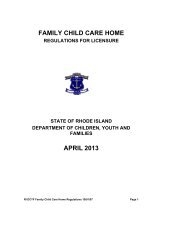system of care for rhode island's children, youth and families
system of care for rhode island's children, youth and families
system of care for rhode island's children, youth and families
You also want an ePaper? Increase the reach of your titles
YUMPU automatically turns print PDFs into web optimized ePapers that Google loves.
CHAPTER 4: FINANCING THE SYSTEM OF CARE<br />
Financing a comprehensive <strong>system</strong> <strong>of</strong> <strong>care</strong> <strong>for</strong> <strong>children</strong>, adolescents, <strong>and</strong> their <strong>families</strong> is one<br />
<strong>of</strong> the most complex aspects <strong>of</strong> <strong>system</strong> re<strong>for</strong>m. Funding <strong>for</strong> services <strong>for</strong> <strong>children</strong> <strong>and</strong> <strong>families</strong><br />
comes from a very broad range <strong>of</strong> federal, state, local, <strong>and</strong> private sector sources. In FY 2001<br />
the DCYF budget exceeded $200 million <strong>and</strong> these funds were augmented from a number <strong>of</strong><br />
other sources including but not limited to public <strong>and</strong> private insurance, federal government<br />
grants <strong>and</strong> contracts, federal entitlements, state general funds, trust funds or other set-asides,<br />
<strong>and</strong> local revenues.<br />
On a State level, funding <strong>and</strong> supports were available from DHS in the <strong>for</strong>m <strong>of</strong> RIte Care<br />
capitation, fee <strong>for</strong> service Medicaid claims, <strong>and</strong> a variety <strong>of</strong> supports available under TANF.<br />
DHS funding <strong>for</strong> programs <strong>for</strong> Families <strong>and</strong> Children in Medicaid alone exceeded $300<br />
million in FY 2001 <strong>and</strong> covered 120,000 family members <strong>of</strong> whom over 80,000 were<br />
<strong>children</strong>. LEAs also were a resource available <strong>for</strong> this <strong>system</strong>, particularly in their growing<br />
role as Medicaid providers.<br />
In the Ideal System <strong>of</strong> Care, DHS <strong>and</strong> DCYF have a strong partnership. DCYF is<br />
responsible <strong>for</strong> developing programs <strong>and</strong> services to meet the needs <strong>of</strong> its priority<br />
populations. DHS is the designated single state agency with responsibility <strong>and</strong> accountability<br />
<strong>for</strong> the Medicaid State Children’s Health Insurance (SCHIP) programs. The majority <strong>of</strong><br />
DCYF <strong>children</strong>, <strong>youth</strong>, <strong>and</strong> <strong>families</strong> are Medicaid/SCHIP eligible. There<strong>for</strong>e, the<br />
opportunity exists to strategically leverage DCYF’s <strong>and</strong> DHS’s authorities <strong>and</strong> resources to<br />
exp<strong>and</strong> services. DHS is a funder with a voice in program development. The responsibility<br />
<strong>for</strong> funding programs is accompanied by participation in design, development, <strong>and</strong><br />
measurement <strong>of</strong> program effectiveness. Likewise, in the ideal <strong>system</strong>, DHS does not<br />
establish programs that directly affect DCYF <strong>children</strong> <strong>and</strong> <strong>families</strong> without DCYF’s full <strong>and</strong><br />
equal participation. These two departments operate as a strategic alliance.<br />
The DHS plays an important role in partnering with the DCYF <strong>and</strong> other state agencies to<br />
maximize Medicaid support <strong>for</strong> eligible <strong>children</strong> <strong>and</strong> their <strong>families</strong>. They continue their<br />
work with DCYF in developing opportunities <strong>for</strong> access to RiteCare coverage <strong>and</strong> their work<br />
with DCYF <strong>and</strong> other state agencies developing opportunities <strong>for</strong> increased access to services<br />
through programs like CEDARR 18 <strong>and</strong> the LCC’s. In the Ideal System, DHS ensures access<br />
to the full range <strong>of</strong> medically necessary prevention <strong>and</strong> treatment services through<br />
contractual language with RIteCare providers. DCYF funds provide non-Medicaid<br />
reimbursable services. In the Ideal System design, the case rate supports the non-Medicaid<br />
reimbursable costs while the Lead Agencies bill Medicaid <strong>for</strong> reimbursable services with the<br />
DCYF providing the State Medicaid share.<br />
18 CEDARR st<strong>and</strong>s <strong>for</strong> Comprehensive Evaluation Diagnosis Assessment Referral <strong>and</strong> Reevaluation <strong>and</strong> is a<br />
collaborative ef<strong>for</strong>t <strong>of</strong> the following state agencies: DHS, DCYF, RIDE, DOH, <strong>and</strong> MHRH. DHS administers<br />
the CEDARR program.<br />
29


